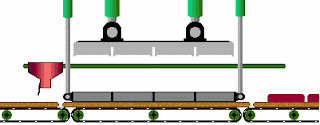Choosing Concrete Pavers
Interlocking concrete pavers, segmental pavers or simply
pavers come in a wide range of sizes, textures and colors. The days of one or two choices are gone. This can make choosing a new patio or walkway
extremely confusing. When looking at
displays at a distributor, take note of these subtle and not so subtle
differences:
1. Paver Type:
Dry Cast
Dry cast pavers are made with a very dry mix of gravel,
sand, cement and color. This mixture is
poured into paver molds then hydraulically pressed and vibrated in the
mold. Since there is very little water
in this dry mix, the molds can be immediately removed and re-used. The pavers will cure, but are already in
their finished state. By using a dry or
zero slump mix, dry cast pavers are quick and easy to produce by machines and
are extremely strong. Concrete mix
produced from a concrete truck will have a psi of 2000 lbs or more. Pavers produced using these hydraulic presses
can easily exceed 8,000 psi. After
pavers have been set, a vibratory plate compactor can be used for final paver
compaction.
Examples of dry cast pavers include Coventry I from EP
Henry, Hera from Techo Bloc and Munich from CST.
Wet cast pavers are produced using a wet concrete mix poured
into a mold. Since this wet mix cannot
be hydraulically pressed, wet cast material will need to set in the mold and
will have a weaker psi, typically 6,500 psi or less. The material must remain in the mold for a
few days meaning the molds cannot be used as often as dry cast materials. The wet cast process, while weaker and more
time consuming allows for bigger sizes and more interesting textures. The process to make wet cast pavers is
strong, but it is too weak to use a tamping machine on for final paver
compaction.
Examples of wet cast products include Devonstone from EP
Henry, Aberdeen from Techo Bloc and Blu Mountain Stone from Kennedy
Concrete/CST.
2. Size/Scale:
Traditional pavers generally include 4x8 Brickstone and 6x6
and 6x9 Old Town Cobble. Pavers now are
available in various sizes from 4”x8” Brickstone up to 30”x30” Monticello. Some pavers use one or two sizes for a
specific pattern while other pavers use five or more sizes to achieve more of a
natural “flagstone” look.
3. Texture:
The surface texture of pavers can include a completely
smooth surface (Village Square, Royale, Contempra), to a tumbled paver (Coventry, Hera, Munich)
or even a more natural look (Bristol, Blu 60, CST Slate Stone). Devonstone and Kennedy Blue Mountain are wet
cast pavers which very closely match the look of natural flagstone in texture,
color and size.
4. Pattern:
Pattern choices are almost as varied as paver choices. Patterns include a very simple one size
pattern such as running bond to two sizes such as an I pattern with Coventry 1
to a multi sized random pattern you can achieve with Brisol, Blu 60, Slate
Stone or natural flagstone.
5. Cost:
Generally, smaller smoother pavers such as Old Town Cobble,
Parisien or Roman Cobble are less expensive than tumbled pavers such as
Coventry 1 or Hera. Additionally, larger
scale and wet cast material such as Monticello or Aberdeen tend to be on the
more expensive side. Some good middle of
the road material includes Munich, Hera, Coventry 1, Blu 60, Slate Stone and
Bristol. While the cost of pavers can
vary greatly, the cost for the other components (2a base stone, sand, edge
restraint ect…) is pretty much the same no matter which material you choose.








